Romanian Food
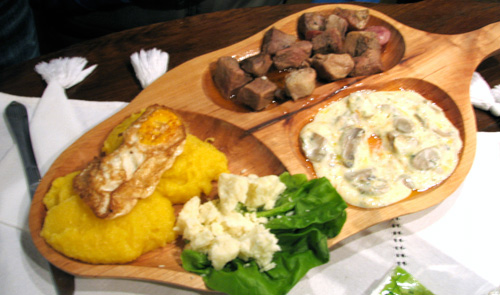
The seasons generally influence the food offered. During summer and autumn markets overflow with fresh vegetables and fruits coming from the local farms.
Radishes, spring onions, potatoes, nettles, spinach, lettuce, tomatoes and cucumbers delight the shoppers in April and May. From the end of May to late September there is a large variety of fruit: cherries, apricots, strawberries, raspberries, plums, pears, melons and watermelons, peaches, blackberries, blueberries, apples, grapes, quinces and nuts.
Beekeeping has always been one of the traditional occupations in Romania, and the products (honey, wax, honeycombs) are also sold on the market.
The best-known dish is sarmale, called also with the diminutive sărmăluţe, (mincemeat wrapped in cabbage or vine leaves) with mămăligă (polenta).
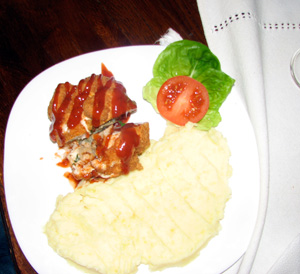
Stews (tocăniţe) made with different kinds of meat (usually chicken and pork) and with vegetables also figure on the restaurant menus, as well as different kinds of soups. Ciorbă de burtă (tripe soup) served with garlic or hot chilli pepper and vinegar is one of the favourites among Romanians.
Pork prepared in different ways is one of the most common ingredients, and all restaurants serve pork chops (cotlet) with French fries and salad.
There are not very many dishes for vegetarians, as Romanians consider a meal without meat very poor indeed. Some dishes are ghiveci (mixed fried vegetables), ardei umpluţi (stuffed peppers, although these might have meat, too) and ouă umplute (filled eggs), besides different kinds of salads and local cheese.
At home, the peasants’ meal almost always contains polenta (mămăligă) that is also known as the “bread of the peasant”. Some centuries ago, when Romania was strictly divided into two social groups, the boyars and the peasants, bread was only eaten by the boyars. Nowadays the situation is different and mămăligă is the traditional dish for everyone, although in towns it is not eaten daily as in the countryside. A traditional combination on farms is mămăligă and smoked pork fat called slănină with garlic, chased with a small glass of ţuică. A dish associated with the life of shepherds on the hills is mămăligă with sheep-milk cheese.
Cabbage rolls ( Sarmale)
1 large soured cabbage, 1 3/4 lb/750 g ground meat (mixture of pork and beef is recommended), 2 large onions, 2 tablespoons rice, 2 tomatoes or 500 mL tomato sauce, salt, pepper, sweet paprika and sour cream (optional).
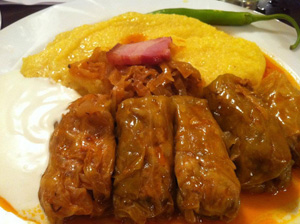
Grind the meat with a raw onion. Place in a bowl and mix with rice, pepper, salt, paprika, and finely chopped onion. Mix everything well.
Core the cabbage with a sharp thin knife. Carefully remove the cabbage leaves, one by one, so that they do not tear. Cut larger leaves in 2 or 3 and then place a little meat in each cabbage piece and roll in. The smaller the rolls are, the tastier they are.
Place a layer of rolls in the pan (take a deep one), then cover with a layer of chopped (julienned) cabbage and the bay leafs, then a layer of thinly sliced tomatoes. Do this layering until all the rolls are made. The last layer must be tomato slices and add tomato sauce. Then place in the oven so that the liquid is reduced. Serve hot with sour cream.
* When soured cabbage is not available, use cabbage leaves scalded in water.
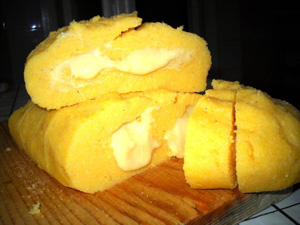
Romanian Style Polenta (Mamaliga)
1 qt. Water, 1-2 cups corn meal, 2 tsp. salt.
Boil water and salt in a pot. When water is boiling, gradually add corn meal while stirring the mixture with a whisk. Stop adding corn meal when the mixture is considerably thick, though still liquid. Continue to simmer for about 10-15 minutes, with caution since the mixture bubbles up and splatters hot polenta around.
Remove from the heat and serve hot with your favorite dish.
[php] //start show banner if country is not finland if(function_exists('wp_ip2nation_getcountry')) { $ip = $_GET["ip"]; if(empty($ip)) { $ip = $_SERVER['REMOTE_ADDR']; } $nation = wp_ip2nation_getcountry($ip); $country = $nation->country; $customIps = array('128.214.211.136'); if (!in_array($ip, $customIps)) { if ($country != "Finland") { echo '[a href="https://www.romanianmonasteries.org/romania/travel-guides-albums-romania/album-romania-people-places-history"][img class="noborder" title="Album Romania - people, places and history" src="https://www.romanianmonasteries.org/images/banner-Romania-people-places-history.jpg" alt="Album Romania - people, places and history" /][/a]'; } } } //end show banner if country is not finland [/php]
Romanian Walnut Panetone (Cozonaci cu nuca)
Romanian Panetone dough: 2 lbs/1 kg flour, 10 oz/300 g sugar, 1 1/2 cups milk, 6 eggs, 2 oz/50 g yeast, 7 oz/200 g butter, 2 tablespoons oil, vanilla stick, salt, egg for washing the dough, grease for the pans.
Make a starter from yeast and a teaspoon of sugar. Mix until the consistency of sour cream, add 2-3 tablespoons tepid milk, a little flour and mix well; sprinkle some flour on top, cover and let sit in a warm place to rise. Boil the milk with the vanilla stick (cut in very small pieces) and leave it on the side of the range, covered, to keep warm.
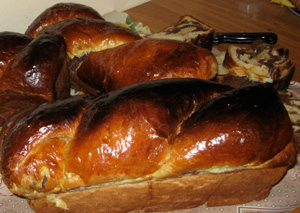
Mix the yolks with the sugar and salt, then slowly pour the tepid milk, stirring continuously. Place the risen starter in a large bowl and pour, stirring continuously, the yolk-milk mixture and some flour, a little at a time. Then add 3 whipped egg whites. When you finish this step, start kneading. Knead, adding melted butter combined with oil, a little at a time, until the dough starts to easily come off your palms. Cover with a cloth and then something thicker (like a blanket).
Leave in a warm place to triple in bulk. If during kneading the dough seems too hard, you may add a little milk. If, on the contrary, the dough seems too soft, you may add a little flour.
Filling: 10 oz/300 g ground walnuts, 1 cup milk, 3/4 cup sugar, 1/4 cup rum, vanilla
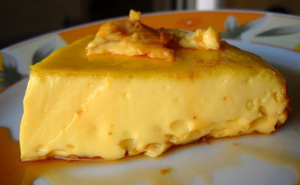
Melt the sugar in the warm milk with vanilla in a pot on the range. When the sugar is melted, add the walnuts and keep stirring. After a few minutes of boiling, and after the filling has thickened, remove from heat and add rum. When the filling is cold, roll a sheet of dough about one finger thick, uniformly spread the walnut filling on top and roll like a jelly roll.
Grease a bread pan, place the roll inside, let rise for a while. Wash with egg and bake at medium heat. Take out of the pan as soon as it is done, place on a cloth and let cool.
Boeuf Salad (Salata de Boeuf)
2 potatoes, 4 carrots, 1 parsley root, 1 parsnip (optional, one can of green peas, 2 pickles, 1/2 lb (250 g) poultry breast or beef sirloin, 300g home made mayonnaise, 1 tablespoon mustard, salt and pepper.
You get the best salad by boiling carrots, parsley root and parsnip with the meat, then take the boiled vegetables and the meat, cut them in cube shape. Separately boil the whole potatoes with skin, then peel and cub them. Cube the pickles as well. Place everything in a bowl, add the peas, mustard and condiments. In a separate bowl, make mayonese. Add ¾ of the mayo mixture to the meat and vegetables and mix. Arrange on a serving platter.
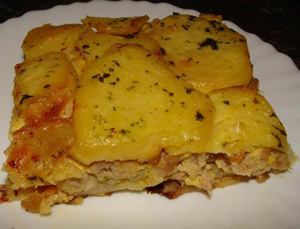
Smooth with a knife and then cover with the rest of the mayo mixture. Garnish with a few olives, hard boiled egg white, or egg slices, pickled red peppers, parsley, etc.
Try to shape flowers, other designs and enjoy!
Other Dishes:
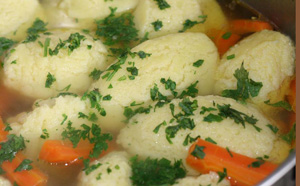
Supa de gaina cu taietei de casa (chicken soup with homemade noodles) is a famous Bucovinean dish. Everyone knows how to prepare this favourite soup with fresh chicken and noodles made at home with wheat flour, eggs, water and salt for taste.
The Tochitura Bucovineana is a dish made of fried pork sausages, fried pork chops, sheep-milk cheese, fried eggs and polenta.
Sarmalute în cuib cu smântâna (mincemeat in cabbage leaves with polenta and sour cream) is a dish served everywhere in Romania. Pork meat is minced and mixed with rice, tomato sauce, eggs and parsley. This mixture is wrapped in fresh or pickled cabbage leaves or vine leaves. They are cooked and served with polenta and sour cream.
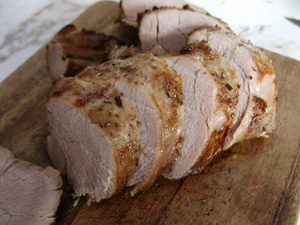
Cârnati de porc cu sfecla rosie (pork sausages with beetroot) are much appreciated. The beetroot salad is prepared with horseradish.
Flora Bucovinei is a stuffed sirloin steak served in Bucovinean restaurants.
Peste prajit cu mamaliguta si mujdei (fried fish with polenta and garlic sauce) is a traditional dish not only in Bucovina but also in all Romania. Fresh fish is covered with wheat and corn flour, is then fried and served with polenta and garlic sauce. Trout and carp are especially popular in the region.
Pastrav în cetina (trout in fir-tree boughs) is usually prepared to last for a longer period. The trout is cleaned and smoked and then kept between fir-tree boughs to get their specific taste.
Piftie de pasare (chicken aspic) is made of chicken cooked with vegetables to give the aspic good taste. The vegetables are re-moved, the meat cleaned and then put with the soup in small bowls. In a cold place the soup will transform into aspic. Pork aspic is prepared in the same way.
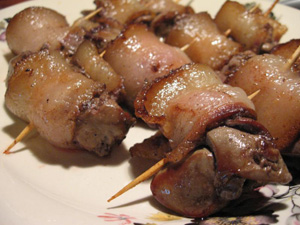
Pui cu smântâna (chicken with cream) is made of chicken cooked in sour cream. It is often served with hot polenta.
Mamaliguta cu ciuperci (polenta with mushrooms) is a dish specific to this region with plenty of forests and mushrooms.
Friptura de caprioara sau de mistret (steak of roe deer or wild boar) is a delicacy that is served rarely.
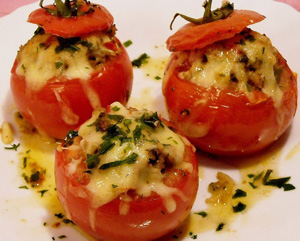
Tocanita de iepure (rabbit stew) is also a special dish. The stew is prepared with red wine that brings out the good taste of the meat.
Rulada de pui (chicken roll) is a dish much appreciated in Bucovina. Most people raise chickens, and the taste of farmyard poultry is superior to “industrial” meat. The dish is prepared with white wine.
Rasol moldovenesc cu hrean (boiled pork, chicken or beef with sour cream and horseradish sauce) is usually served with polenta.
Pui câmpulungean (chicken in the style of Câmpulung Moldovenesc) is chicken stuffed with smoked bacon, sausages, garlic and vegetables.
Pârjoale (meatballs) is the traditional Moldavian dish made of pork meat, eggs, onion, potatoes and garlic, all minced together. Salt, pepper and dill are added for taste and the meatballs are fried.
Clatite cu carne si ciuperci (pancakes with meat and mushrooms) are also baked in the oven after the filling mixture is ready. Pork or beef meat are used to prepare this meal.
[php] //start show banner if country is not finland if(function_exists('wp_ip2nation_getcountry')) { $ip = $_GET["ip"]; if(empty($ip)) { $ip = $_SERVER['REMOTE_ADDR']; } $nation = wp_ip2nation_getcountry($ip); $country = $nation->country; $customIps = array('128.214.211.136'); if (!in_array($ip, $customIps)) { if ($country != "Finland") { echo '[a href="https://www.romanianmonasteries.org/romania/travel-guides-albums-romania/greeting-from-romania-with-love"][img class="noborder" title="Album Greeting from Romania with Love" src="https://www.romanianmonasteries.org/images/banner-Romania-love-en.jpg" alt="Album Greeting from Romania with Love" /][/a]'; } } } //end show banner if country is not finland [/php]
Desserts (Desert):
“Poale-n brâu” pies are made either with sweet or salty cheese. The dough is wrapped into an envelope and filled with cheese.
Clatite cu brânza (pancakes with cheese) are baked in the oven with cream.
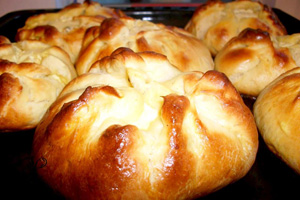
Papanasi cu brânza (cream cheese dumplings) are either fried or boiled and served hot with jam.
Lapte de pasare (floating is-lands), consist of stiff egg whites floating in vanilla sauce.
Wine, beer and water
The national drink is the double-distilled tuica, usually made with plums, but also with apples and pears. An even stronger variant is called palinca. Both are homemade, as are the visinata, made with cherries, and the afinata, made with blueberries. Beer is popular and there is a large variety of lagers (bere blonda) and brown ales (bere neagra), usually sold in bottles.
Romanian wines are very good. Commercial vineyards have existed since the 17th century and are found all over the country. Romania’s great labels come from Cotnari, Dealu Mare, Nicoresti, Niculitel and Odobesti. Sparkling wines from Panciu or Bucium are also much appreciated. Many Romanians make their own wine using traditional fermentation methods, without any chemicals. There are many varieties of grapes like “Grasa de Cotnari“, “Dealu Mare“, “Busuioaca de Bohotin“, “Lacrima Lui Ovidiu“, “Tamâioasa Românesca” or “Frâncusa de Cotnari“, but the white “Feteasca Alba” is said to be the first true Romanian grape.
Romania is full of mineral water springs, and there are many bottled water brands, such as Poiana Negri, Dorna, Borsec, Izvorul Minunilor and Amfiteatru. Many people also go to public springs and fill their own bottles.
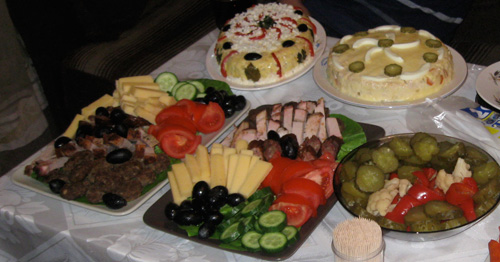
 Travel Bucovina
Travel Bucovina Travel Maramures
Travel Maramures Travel Romania
Travel Romania Other Monasteries from Romania
Other Monasteries from Romania
